Diagnosing the underlying causes for changes in the Earth’s climate is a tricky and controversial business.
Because of this, people tend to focus on the political. Everyone has an opinion on climate change. Is it man-made? Is it due to natural cycles of heating and cooling? Is it a hoax perpetrated by the Chinese?
It’s easy to overlook the fact that the actual work being done in climate science, being subject to so much scrutiny (and being relatively well funded), is utterly, ridiculously, absurdly cool.
An investigation undertaken by a team of researchers from the Netherlands and the Czech Republic serves as a sampler to the many insights yielded by this extraordinary field- and why we must embrace complexity when it comes to dealing with the most pressing issue of our time.
Changes in climate are generally ascribed to two types of forces: internal and external.
Internal forces originate on or within the Earth- volcanic activity, glacier melting, mass extinctions, and man-made activity are but a few examples.
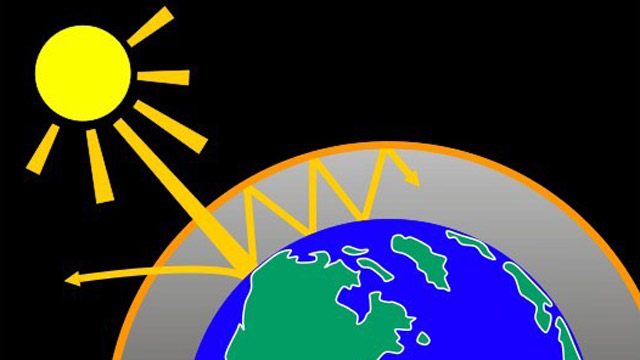
The Greenhouse effect is probably the most well known example of internal forcing
External forces involve the Earth’s relationship to extraterrestrial entities, usually the sun. Examples include the changing shape of the Earth’s orbit, fluctuations on the Sun’s surface, and asteroid impacts.
Rapid changes in climate (over the course of a few thousand years) are generally due to internal forces, and usually involve ice sheets.
As the climate warms, ice melts and releases gases trapped within, causing the climate to warm even more rapidly- this is an integral component of contemporary, man-made climate change. The reverse occurs as well, with ice sheets trapping huge quantities of gases as they form, causing the Earth to cool even further.
During older periods of the Earth’s history, ice sheets were largely absent. And yet, rapid changes in climate still occurred, albeit not as frequently.
One such period was the Devonian period, which spanned from approximately 419 million years ago to 359 million years ago.

The Devonian Period is known as the Age of Fish, where marine life exploded in biodiversity
The Devonian period featured a warm, stable greenhouse climate (with large quantities of carbon dioxide in the air). These conditions allowed life to thrive and evolve in new ways, facilitating the emergence of plant life and the first land animals.
How, then, can such a period also include rapid cycles of heating and cooling?
Internal forces had not yet truly emerged, as these typically require large ice sheets or life to absorb and release huge quantities of greenhouse gases (the latter of which could only occur after plant life became prominent).
So the prevailing theory is that somehow, external forces are involved.
One such force, oft-cited amongst the man-made climate change denial crowd, is called the Hallstatt cycle. It involves fluctuations on the sun’s surface, manifesting in the size and intensity of sunspots over a long period of time
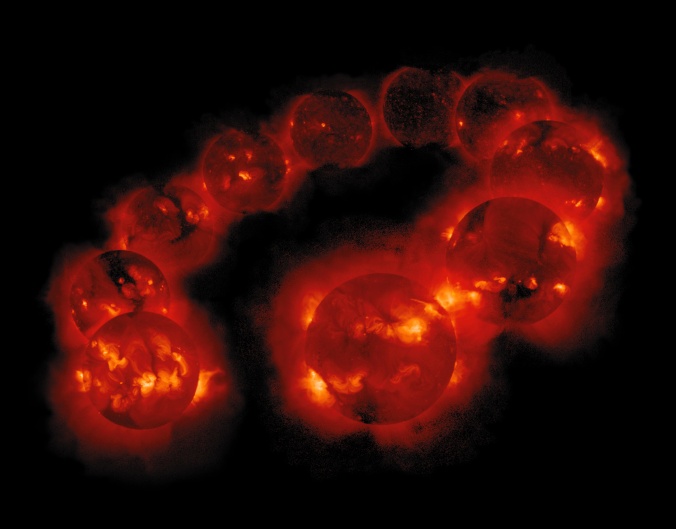
A stunning example of a time series of sunspot photographs, displaying sunspots fading and flaring in intensity over time. Note this is NOT the Hallstatt cycle (which occurs over 2.4 thousand years) but is a far shorter solar cycle
These cycles last approximately 2400 years. Evidence for their existence can be found in variations in carbon and oxygen atoms, called isotopes.
As radiation from the sun intensifies, atoms have a slight tendency to gain a few extra particles, like a freshman putting on a few pounds at the beginning of his university career.
During the Hallstatt cycle, the sun will gradually intensify over 2400 years, peaking, then waning over the next 2400 years. This waxing and waning is reflected in the number of Carbon-14 and Oxygen-18 atoms found in various sediments and soils dating back to different geological time periods.
The Czech/Netherlands team studied slices of rock approximately 1 cm thick for evidence of these atoms, as well as for other stories only ancient rocks can tell. Different combinations of trace elements and alternative atomic configurations reveal patterns in the Earth’s history- patterns that can be cross referenced with other observable phenomena to complete the picture.
This periodic fluctuation in the amount of O-18 was reflected beautifully in one of the layers of rock studied by the Czech/Netherlands team, accounting for one of the rapid periods of climate change.
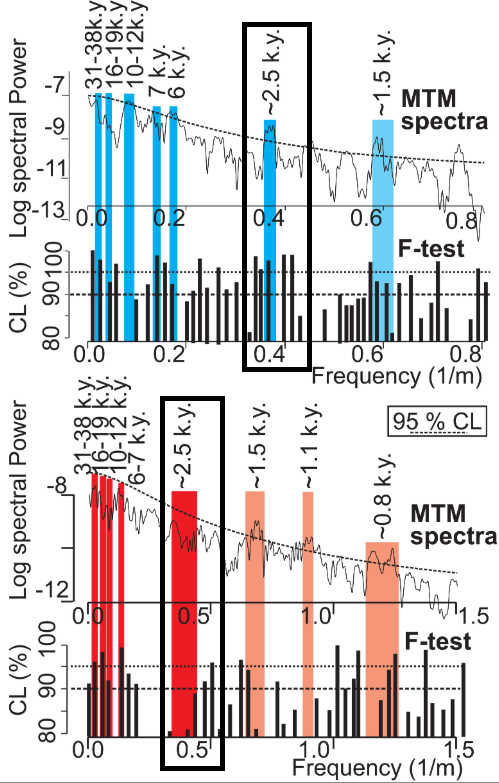
This is, admittedly, a terrifying image. Basically, the top graph shows a dip, to peak, to dip which corresponds to about 2500 years, while the bottom shows a peak to a dip to a peak, also lasting 2500 years. These are exactly the intervals described by the Hallstatt cycle
But there were other periods of change that were not neatly explained by the 2400 year cycle. These included cycles of heating and cooling that lasted between 5000 and 15000 years.
If these were not caused by the Halstatt cycle, then by what mechanism do they exist?
The answer, curiously, has a lot to do with music.
Certain pairs of musical notes, when played in unison, can generate additional notes called combination tones. They are also referred to as Tartini Tones, after the violinist Giuseppe Tartini.

This handsome devil is Giuseppe Tartini. Tangentially, he is known for composing a piece called the Devil’s Sonata
To break it down, imagine two saxophone players sitting across from each other. Try not to swoon. They each play a different note and hold it, quite loudly. Depending on what the notes are, you will hear a third note, sometimes higher, sometimes lower, than what the two players are actually playing.
It was thought that this third note was the ear ‘filling in the gap’, creating full chords out of mere skeletons, but as it turns out, the additional notes are actually generated.
Musical notes are essentially the air vibrating at a certain frequency. Combination tones are either the sum of the frequencies of two notes (which produces a higher pitch), or the difference (which produces a lower).
But anything that behaves in a cyclical pattern has a frequency- and while musical notes happen to have relatively high frequencies (in the order of hundreds of cycles per second), other phenomena can have frequencies on the order of one cycle per thousands of years.
Such as planetary motion cycles.
The Earth has many such cycles. It rotates about its axis- one rotation is equal to a day. It revolves around the sun- one revolution is a year.
It is also tilted, and the angle of the tilt changes between 21.5 degrees and 24.5 degrees over the course of about 41,000 years.
In addition to being tilted, the axis also wobbles due to the interaction between the Sun’s gravity and the moon’s gravity. This wobbling occurs cyclically over the course of about 26,000 years.
And finally, the Earth’s orbit around the sun changes shape. It is not perfectly circular, but rather ellipsoidal. It becomes more and less ellipsoidal over the course of over 100,000 years.
These three cycles (the degree to which the Earth is tilted, the wobbling of the axis, and the shape of the Earth’s orbit around the sun) are referred to as Milankovitch cycles, and are prime examples of external forces on climate.
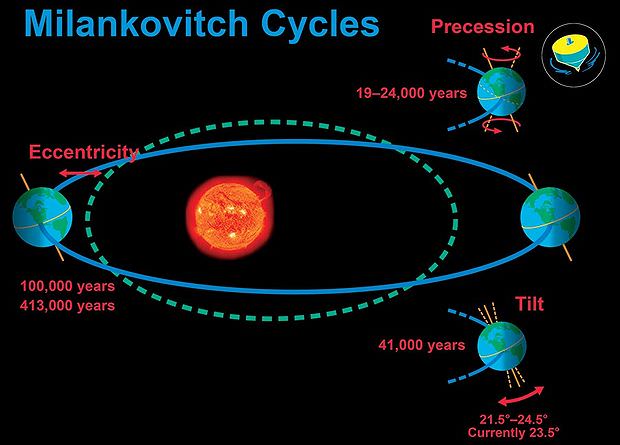
The three Milankovitch cycles
But by themselves, they cannot produce the rapid series of heating and cooling observed in analysis of soil samples, the ones occurring between 5000 and 15,000 years in length.
This is where combination tones come in.
The Dutch/Czech team theorized that the Devonian cycles of rapid heating and cooling (specifically the ones between 5000 and 15,000 years in length) were caused by combination tones created by the Milankovitch cycles.
This was not a new theory, necessarily. But they actually tested it.
Using spectral analysis of the same soil samples used to identify the Halstatt cycle, they predicted that if they were to isolate each of the Milankovitch cycles individually, they would find periods of resonance which result in amplified signals in the spectrometer. And they were right.
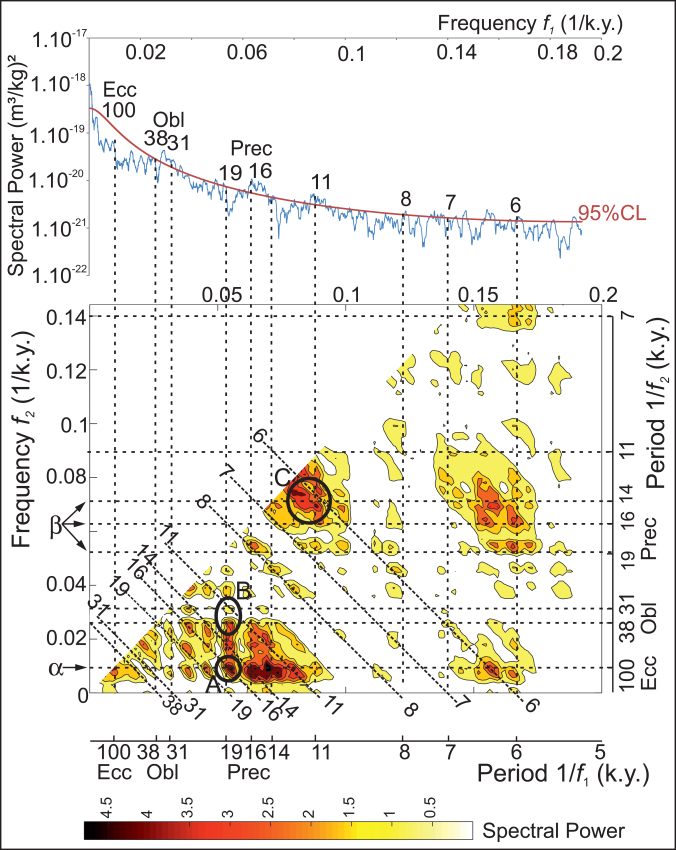
Another horrific image. Each of these dotted lines represents a Milankovitch cycle. Ecc (eccentricity) refers to the wobble of the Earth on its axis. Obl (oblique) refers to the tilt angle of the axis. And Prec (precession) refers to the shape of the orbit. These dotted lines intersect each other, and provide an amplified signal on the spectrometer
There is an ancient idea put forth by the great mathematician Pythagoras. It is called Musica universalis, or Music of the Spheres. He posited that each of the celestial bodies hummed and resonated with each other to produce cycles of prosperity on Earth.

Aristotle (as he is wont to) trashed the idea but it remained popular among the more poetic academics. And it seems as though there was a note of truth to it after all.
Science is not an ideology, nor is it truth. It is merely a collection of methods that helps us to circumvent our cognitive biases and test our theories. It is a way of parsing through the chaos of nature to find the hums and beats that lie underneath. And when we find those beats, we can, in small ways, resonate with them.
To do that, we must cut back on the arguing, the politics, the heated clashes of opinion versus opinion, activities whose noise drowns out the results of genuine scientific exploration. We must quiet down. We must simply observe, and listen.
Sources:
Da Silva A.C et al. (2018). Millennial-scale climate changes manifest Milankovitch combination tones and Hallstatt solar cycles in the Devonian greenhouse world. Geology (2018) 47 (1): 19-22
Le Treut. (1983). Orbital Forcing, Climatic Interactions, and Glaciation Cycles. Jour Geophys Res (1983) 88 (C9): 5167-5190
Image of greenhouse effect retrieved from https://www.wonderworksonline.com/science-library/atmosphere-climate/greenhouse-effect/
Image of Devonian Period retrieved from http://natural.world/devonian-period.html
Image of sunspot time series retrieved from https://en.wikipedia.org/wiki/Solar_cycle
Image of Tartini retrieved from https://aviolinslife.org/tartinilipinski/
Image of Milankovitch cycles retrieved from https://www.universetoday.com/39012/milankovitch-cycle/